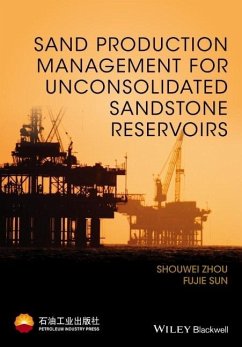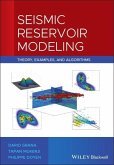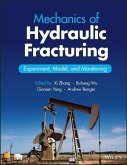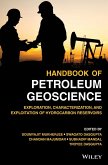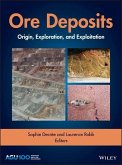- Gebundenes Buch
- Merkliste
- Auf die Merkliste
- Bewerten Bewerten
- Teilen
- Produkt teilen
- Produkterinnerung
- Produkterinnerung
This book investigates sand production problems in the development of unconsolidated sand reservoirs and suggests novel technical solutions and improvements to sand management issues.
This book is divided into six chapters: (1) geologic characteristics of unconsolidated sand heavy oil reservoirs and concept of sand management technology; (2) sand production mechanisms and its effect on reservoir petrophysical quality; (3) sand production quantity prediction and well productivity evaluation methods, especially for fluid-solid coupling prediction model; (4) completion technology for sand…mehr
Andere Kunden interessierten sich auch für
![Seismic Reservoir Modeling Seismic Reservoir Modeling]() Dario GranaSeismic Reservoir Modeling131,99 €
Dario GranaSeismic Reservoir Modeling131,99 €![Mechanics of Hydraulic Fracturing Mechanics of Hydraulic Fracturing]() Mechanics of Hydraulic Fracturing192,99 €
Mechanics of Hydraulic Fracturing192,99 €![Mathematical Geoenergy Mathematical Geoenergy]() Paul PukiteMathematical Geoenergy231,99 €
Paul PukiteMathematical Geoenergy231,99 €![Handbook of Petroleum Geoscience Handbook of Petroleum Geoscience]() Handbook of Petroleum Geoscience181,99 €
Handbook of Petroleum Geoscience181,99 €![Quantifying Uncertainty in Subsurface Systems Quantifying Uncertainty in Subsurface Systems]() Quantifying Uncertainty in Subsurface Systems224,99 €
Quantifying Uncertainty in Subsurface Systems224,99 €![Seismic Inversion Seismic Inversion]() Yanghua WangSeismic Inversion108,99 €
Yanghua WangSeismic Inversion108,99 €![Ore Deposits Ore Deposits]() Ore Deposits223,99 €
Ore Deposits223,99 €-
-
-
This book investigates sand production problems in the development of unconsolidated sand reservoirs and suggests novel technical solutions and improvements to sand management issues.
This book is divided into six chapters: (1) geologic characteristics of unconsolidated sand heavy oil reservoirs and concept of sand management technology; (2) sand production mechanisms and its effect on reservoir petrophysical quality; (3) sand production quantity prediction and well productivity evaluation methods, especially for fluid-solid coupling prediction model; (4) completion technology for sand management; (5) sand flow in well bore and surface processing; (6) the application of sand management technology in China's Bohai heavy oil field.
Readership: Petroleum reservoir engineers and production managers worldwide.
Hinweis: Dieser Artikel kann nur an eine deutsche Lieferadresse ausgeliefert werden.
This book is divided into six chapters: (1) geologic characteristics of unconsolidated sand heavy oil reservoirs and concept of sand management technology; (2) sand production mechanisms and its effect on reservoir petrophysical quality; (3) sand production quantity prediction and well productivity evaluation methods, especially for fluid-solid coupling prediction model; (4) completion technology for sand management; (5) sand flow in well bore and surface processing; (6) the application of sand management technology in China's Bohai heavy oil field.
Readership: Petroleum reservoir engineers and production managers worldwide.
Hinweis: Dieser Artikel kann nur an eine deutsche Lieferadresse ausgeliefert werden.
Produktdetails
- Produktdetails
- Verlag: Wiley & Sons / Wiley-Blackwell
- Artikelnr. des Verlages: 1W118961890
- 1. Auflage
- Seitenzahl: 184
- Erscheinungstermin: 21. März 2016
- Englisch
- Abmessung: 246mm x 170mm x 15mm
- Gewicht: 544g
- ISBN-13: 9781118961896
- ISBN-10: 1118961897
- Artikelnr.: 43749821
- Herstellerkennzeichnung
- Libri GmbH
- Europaallee 1
- 36244 Bad Hersfeld
- 06621 890
- Verlag: Wiley & Sons / Wiley-Blackwell
- Artikelnr. des Verlages: 1W118961890
- 1. Auflage
- Seitenzahl: 184
- Erscheinungstermin: 21. März 2016
- Englisch
- Abmessung: 246mm x 170mm x 15mm
- Gewicht: 544g
- ISBN-13: 9781118961896
- ISBN-10: 1118961897
- Artikelnr.: 43749821
- Herstellerkennzeichnung
- Libri GmbH
- Europaallee 1
- 36244 Bad Hersfeld
- 06621 890
Zhou Shouwei, former Vice-President of CNOOC and Director of CNOOC's EOR key lab, is an academician of the Chinese Academy of Engineering, specialising in offshore oil development engineering. Sun Fujie, General Manager of Technology Development, Department of CNOOC, is a senior engineer with expertise in oil and gas field development engineering. He joined CNOOC in 1988, working on production of offshore oil and gas field development.
Foreword ix
Preface xi
1 Introduction 1
1.1 Geological Characteristics of Unconsolidated Heavy Oil Sandstone Reservoirs 1
1.1.1 Distribution Characteristics of Unconsolidated Heavy Oil Sandstone Reservoirs 1
1.1.2 Sedimentary Characteristics of Unconsolidated Sandstone Reservoirs 2
1.1.3 Diagenetic Features of Unconsolidated Sandstone Reservoirs 2
1.1.4 Characteristics of Reservoir Space of Unconsolidated Sandstone Reservoirs 4
1.1.5 Fluid Properties of Unconsolidated Sandstone Reservoirs 8
1.1.6 Flowing Characteristics of Unconsolidated Sandstone Reservoirs 10
1.2 Development Technologies Management of Unconsolidated Sandstone Reservoirs 12
1.2.1 Development Characteristics of Unconsolidated Sandstone Reservoirs 12
1.2.2 Technical Philosophy of Sand Production Management 13
1.2.3 Key Technologies 14
1.2.4 Limited Sand Production Management 16
1.2.5 Measures of Controlling Sand Production 21
1.2.6 Application of Sand Production Management 27
1.2.7 Development Prospects of Unconsolidated Sandstone Reservoirs 29
2 Sand Production Mechanism and Changes of Rock Properties Affected by Sand Production 31
2.1 Sand Production Mechanism and the Factors Affecting Sand Production 31
2.1.1 Mechanism of Sand Production 31
2.1.2 Factors Affecting Sand Production 33
2.2 Changes of Formation Properties due to Sand Production 36
2.2.1 Experiments Observing Influence of Sand Production on Permeability 36
2.2.2 Influence of Sand Production on Porosity Structure 45
3 Sand Production Rate Prediction and Productivity Index Appraisal 56
3.1 Evolvement of Sand Production Rate Prediction Method 57
3.1.1 Wellsite Engineering Method 57
3.1.2 Stress?]Strain Model 58
3.1.3 Wormhole Model 60
3.1.4 Solid-Fluid Coupling Model 62
3.2 Sand Production Rate Prediction by Using Fluid-Solid Coupling Model 64
3.2.1 The Principle of Calculation 64
3.2.2 Erosion Model 68
3.2.3 Denudation Model 75
3.3 Productivity Appraisal Methods of Wells Producing with Sands 79
3.3.1 Model of Skin Factor 79
3.3.2 Improved Permeability Model 80
3.3.3 Equivalent Wellbore Model of Sanding Tunnels 81
3.3.4 Solving Process 82
3.4 Cases of Increasing Production Rate by Allowing Sand Production 83
3.4.1 Required Parameters for Calculation 83
3.4.2 Controlling the Bottom Hole Pressure 84
3.4.3 Results of Calculation 84
4 Well Completion Approaches of Sanding Management 89
4.1 Methods of Excluding Sand Production 89
4.1.1 Conventional Methods of Excluding Sand Production 90
4.1.2 Methods of Excluding Sand Production of Sand Production Management 90
4.2 Design of Sand Exclusion Parameters 92
4.2.1 Designing Aperture Width of Sand Production Exclusion Screens 92
4.2.2 Designing Methods of Sand Exclusion Precision for Premium Screens 96
4.2.3 Approach of Gravel?]packing 98
4.3 Physical Simulation of Evaluating Sand Control Results 99
4.3.1 Experimental Devices 100
4.3.2 Experimental Evaluation Index 102
4.3.3 Evaluation Experiments of Sand Exclusion Precision of Premium Screens 103
4.3.4 Evaluation Experiments of Packing Gravel Sizes 105
5 Sand Carrying in Wellbore and Surface Treatment of Produced Sands 108
5.1 Critical Flowing Velocity of Carrying Sand in Wellbore when Producing with Sands 108
5.1.1 Basic Theoretical Model 109
Preface xi
1 Introduction 1
1.1 Geological Characteristics of Unconsolidated Heavy Oil Sandstone Reservoirs 1
1.1.1 Distribution Characteristics of Unconsolidated Heavy Oil Sandstone Reservoirs 1
1.1.2 Sedimentary Characteristics of Unconsolidated Sandstone Reservoirs 2
1.1.3 Diagenetic Features of Unconsolidated Sandstone Reservoirs 2
1.1.4 Characteristics of Reservoir Space of Unconsolidated Sandstone Reservoirs 4
1.1.5 Fluid Properties of Unconsolidated Sandstone Reservoirs 8
1.1.6 Flowing Characteristics of Unconsolidated Sandstone Reservoirs 10
1.2 Development Technologies Management of Unconsolidated Sandstone Reservoirs 12
1.2.1 Development Characteristics of Unconsolidated Sandstone Reservoirs 12
1.2.2 Technical Philosophy of Sand Production Management 13
1.2.3 Key Technologies 14
1.2.4 Limited Sand Production Management 16
1.2.5 Measures of Controlling Sand Production 21
1.2.6 Application of Sand Production Management 27
1.2.7 Development Prospects of Unconsolidated Sandstone Reservoirs 29
2 Sand Production Mechanism and Changes of Rock Properties Affected by Sand Production 31
2.1 Sand Production Mechanism and the Factors Affecting Sand Production 31
2.1.1 Mechanism of Sand Production 31
2.1.2 Factors Affecting Sand Production 33
2.2 Changes of Formation Properties due to Sand Production 36
2.2.1 Experiments Observing Influence of Sand Production on Permeability 36
2.2.2 Influence of Sand Production on Porosity Structure 45
3 Sand Production Rate Prediction and Productivity Index Appraisal 56
3.1 Evolvement of Sand Production Rate Prediction Method 57
3.1.1 Wellsite Engineering Method 57
3.1.2 Stress?]Strain Model 58
3.1.3 Wormhole Model 60
3.1.4 Solid-Fluid Coupling Model 62
3.2 Sand Production Rate Prediction by Using Fluid-Solid Coupling Model 64
3.2.1 The Principle of Calculation 64
3.2.2 Erosion Model 68
3.2.3 Denudation Model 75
3.3 Productivity Appraisal Methods of Wells Producing with Sands 79
3.3.1 Model of Skin Factor 79
3.3.2 Improved Permeability Model 80
3.3.3 Equivalent Wellbore Model of Sanding Tunnels 81
3.3.4 Solving Process 82
3.4 Cases of Increasing Production Rate by Allowing Sand Production 83
3.4.1 Required Parameters for Calculation 83
3.4.2 Controlling the Bottom Hole Pressure 84
3.4.3 Results of Calculation 84
4 Well Completion Approaches of Sanding Management 89
4.1 Methods of Excluding Sand Production 89
4.1.1 Conventional Methods of Excluding Sand Production 90
4.1.2 Methods of Excluding Sand Production of Sand Production Management 90
4.2 Design of Sand Exclusion Parameters 92
4.2.1 Designing Aperture Width of Sand Production Exclusion Screens 92
4.2.2 Designing Methods of Sand Exclusion Precision for Premium Screens 96
4.2.3 Approach of Gravel?]packing 98
4.3 Physical Simulation of Evaluating Sand Control Results 99
4.3.1 Experimental Devices 100
4.3.2 Experimental Evaluation Index 102
4.3.3 Evaluation Experiments of Sand Exclusion Precision of Premium Screens 103
4.3.4 Evaluation Experiments of Packing Gravel Sizes 105
5 Sand Carrying in Wellbore and Surface Treatment of Produced Sands 108
5.1 Critical Flowing Velocity of Carrying Sand in Wellbore when Producing with Sands 108
5.1.1 Basic Theoretical Model 109
Foreword ix
Preface xi
1 Introduction 1
1.1 Geological Characteristics of Unconsolidated Heavy Oil Sandstone Reservoirs 1
1.1.1 Distribution Characteristics of Unconsolidated Heavy Oil Sandstone Reservoirs 1
1.1.2 Sedimentary Characteristics of Unconsolidated Sandstone Reservoirs 2
1.1.3 Diagenetic Features of Unconsolidated Sandstone Reservoirs 2
1.1.4 Characteristics of Reservoir Space of Unconsolidated Sandstone Reservoirs 4
1.1.5 Fluid Properties of Unconsolidated Sandstone Reservoirs 8
1.1.6 Flowing Characteristics of Unconsolidated Sandstone Reservoirs 10
1.2 Development Technologies Management of Unconsolidated Sandstone Reservoirs 12
1.2.1 Development Characteristics of Unconsolidated Sandstone Reservoirs 12
1.2.2 Technical Philosophy of Sand Production Management 13
1.2.3 Key Technologies 14
1.2.4 Limited Sand Production Management 16
1.2.5 Measures of Controlling Sand Production 21
1.2.6 Application of Sand Production Management 27
1.2.7 Development Prospects of Unconsolidated Sandstone Reservoirs 29
2 Sand Production Mechanism and Changes of Rock Properties Affected by Sand Production 31
2.1 Sand Production Mechanism and the Factors Affecting Sand Production 31
2.1.1 Mechanism of Sand Production 31
2.1.2 Factors Affecting Sand Production 33
2.2 Changes of Formation Properties due to Sand Production 36
2.2.1 Experiments Observing Influence of Sand Production on Permeability 36
2.2.2 Influence of Sand Production on Porosity Structure 45
3 Sand Production Rate Prediction and Productivity Index Appraisal 56
3.1 Evolvement of Sand Production Rate Prediction Method 57
3.1.1 Wellsite Engineering Method 57
3.1.2 Stress?]Strain Model 58
3.1.3 Wormhole Model 60
3.1.4 Solid-Fluid Coupling Model 62
3.2 Sand Production Rate Prediction by Using Fluid-Solid Coupling Model 64
3.2.1 The Principle of Calculation 64
3.2.2 Erosion Model 68
3.2.3 Denudation Model 75
3.3 Productivity Appraisal Methods of Wells Producing with Sands 79
3.3.1 Model of Skin Factor 79
3.3.2 Improved Permeability Model 80
3.3.3 Equivalent Wellbore Model of Sanding Tunnels 81
3.3.4 Solving Process 82
3.4 Cases of Increasing Production Rate by Allowing Sand Production 83
3.4.1 Required Parameters for Calculation 83
3.4.2 Controlling the Bottom Hole Pressure 84
3.4.3 Results of Calculation 84
4 Well Completion Approaches of Sanding Management 89
4.1 Methods of Excluding Sand Production 89
4.1.1 Conventional Methods of Excluding Sand Production 90
4.1.2 Methods of Excluding Sand Production of Sand Production Management 90
4.2 Design of Sand Exclusion Parameters 92
4.2.1 Designing Aperture Width of Sand Production Exclusion Screens 92
4.2.2 Designing Methods of Sand Exclusion Precision for Premium Screens 96
4.2.3 Approach of Gravel?]packing 98
4.3 Physical Simulation of Evaluating Sand Control Results 99
4.3.1 Experimental Devices 100
4.3.2 Experimental Evaluation Index 102
4.3.3 Evaluation Experiments of Sand Exclusion Precision of Premium Screens 103
4.3.4 Evaluation Experiments of Packing Gravel Sizes 105
5 Sand Carrying in Wellbore and Surface Treatment of Produced Sands 108
5.1 Critical Flowing Velocity of Carrying Sand in Wellbore when Producing with Sands 108
5.1.1 Basic Theoretical Model 109
Preface xi
1 Introduction 1
1.1 Geological Characteristics of Unconsolidated Heavy Oil Sandstone Reservoirs 1
1.1.1 Distribution Characteristics of Unconsolidated Heavy Oil Sandstone Reservoirs 1
1.1.2 Sedimentary Characteristics of Unconsolidated Sandstone Reservoirs 2
1.1.3 Diagenetic Features of Unconsolidated Sandstone Reservoirs 2
1.1.4 Characteristics of Reservoir Space of Unconsolidated Sandstone Reservoirs 4
1.1.5 Fluid Properties of Unconsolidated Sandstone Reservoirs 8
1.1.6 Flowing Characteristics of Unconsolidated Sandstone Reservoirs 10
1.2 Development Technologies Management of Unconsolidated Sandstone Reservoirs 12
1.2.1 Development Characteristics of Unconsolidated Sandstone Reservoirs 12
1.2.2 Technical Philosophy of Sand Production Management 13
1.2.3 Key Technologies 14
1.2.4 Limited Sand Production Management 16
1.2.5 Measures of Controlling Sand Production 21
1.2.6 Application of Sand Production Management 27
1.2.7 Development Prospects of Unconsolidated Sandstone Reservoirs 29
2 Sand Production Mechanism and Changes of Rock Properties Affected by Sand Production 31
2.1 Sand Production Mechanism and the Factors Affecting Sand Production 31
2.1.1 Mechanism of Sand Production 31
2.1.2 Factors Affecting Sand Production 33
2.2 Changes of Formation Properties due to Sand Production 36
2.2.1 Experiments Observing Influence of Sand Production on Permeability 36
2.2.2 Influence of Sand Production on Porosity Structure 45
3 Sand Production Rate Prediction and Productivity Index Appraisal 56
3.1 Evolvement of Sand Production Rate Prediction Method 57
3.1.1 Wellsite Engineering Method 57
3.1.2 Stress?]Strain Model 58
3.1.3 Wormhole Model 60
3.1.4 Solid-Fluid Coupling Model 62
3.2 Sand Production Rate Prediction by Using Fluid-Solid Coupling Model 64
3.2.1 The Principle of Calculation 64
3.2.2 Erosion Model 68
3.2.3 Denudation Model 75
3.3 Productivity Appraisal Methods of Wells Producing with Sands 79
3.3.1 Model of Skin Factor 79
3.3.2 Improved Permeability Model 80
3.3.3 Equivalent Wellbore Model of Sanding Tunnels 81
3.3.4 Solving Process 82
3.4 Cases of Increasing Production Rate by Allowing Sand Production 83
3.4.1 Required Parameters for Calculation 83
3.4.2 Controlling the Bottom Hole Pressure 84
3.4.3 Results of Calculation 84
4 Well Completion Approaches of Sanding Management 89
4.1 Methods of Excluding Sand Production 89
4.1.1 Conventional Methods of Excluding Sand Production 90
4.1.2 Methods of Excluding Sand Production of Sand Production Management 90
4.2 Design of Sand Exclusion Parameters 92
4.2.1 Designing Aperture Width of Sand Production Exclusion Screens 92
4.2.2 Designing Methods of Sand Exclusion Precision for Premium Screens 96
4.2.3 Approach of Gravel?]packing 98
4.3 Physical Simulation of Evaluating Sand Control Results 99
4.3.1 Experimental Devices 100
4.3.2 Experimental Evaluation Index 102
4.3.3 Evaluation Experiments of Sand Exclusion Precision of Premium Screens 103
4.3.4 Evaluation Experiments of Packing Gravel Sizes 105
5 Sand Carrying in Wellbore and Surface Treatment of Produced Sands 108
5.1 Critical Flowing Velocity of Carrying Sand in Wellbore when Producing with Sands 108
5.1.1 Basic Theoretical Model 109

